May Fair Cameras
Ardath Tobacco Company Premium Scheme
Background
This page is dedicated to the series of cameras and accessories that were made available as premium gifts in exchange for coupons issued with cigarettes produced by the Ardath Tobacco Company Ltd. The information on this page formed the basis of an article that appeared in Photographica World (PW No 146), the journal of the Photographic Collectors Club of Great Britain. This page includes some additional content that did not appear in the article, and has also been updated since the article was published to reflect the outcome of further research.
In common with many other premium schemes, Ardath produced a regular series of catalogues that listed the gifts that were available at that time in exchange for a specified number of coupons. Ardath referred to the gifts as "reminders" and to the coupons as "certificates". A wide range of gifts were available, from inexpensive kitchen and household items to watches, furniture and jewellery. The catalogues are numbered and each full issue superseded its predecessor. The catalogues state that Ardath's policy was to "avoid the usual forms of expensive advertising and instead offer Smokers useful Reminders in return for the Certificates enclosed in every packet of Ardath Cigarettes".
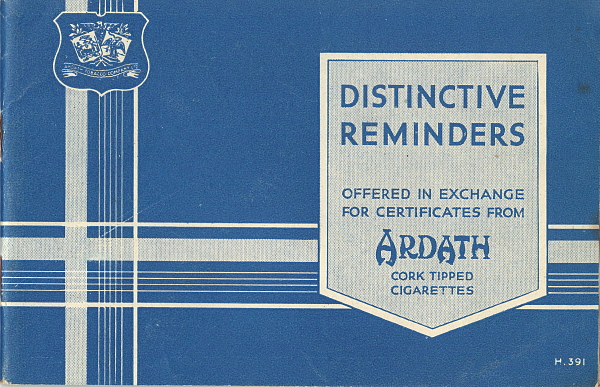
The catalogues include black & white illustrations of the items along with short descriptions and state the number of coupons that had to be redeemed for each item. The coupons themselves were issued with particular brands of their cigarettes, inserted inside the packets. The coupon shown below was issued with Ardath Virginia cigarettes and is believed to date to 1931 or possibly earlier.
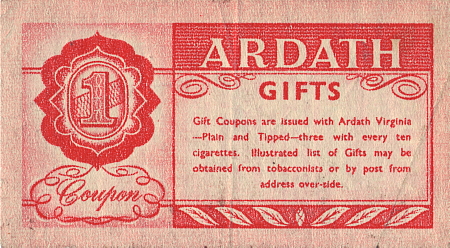
The Ardath premium scheme started in 1927 and ceased on December 31, 1933, although coupons were still honoured until the end of February 1934. This is verified by the coupon shown below that is overprinted with the deadline date.
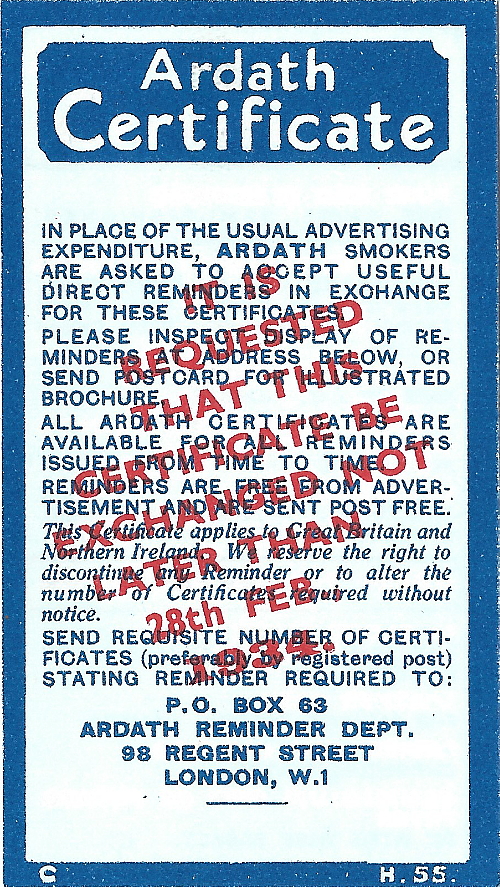
The Ardath Tobacco Company was sold in 1925, with British American Tobacco acquiring rights to overseas sales, while the Imperial Tobacco Group acquired the rights of sale within the United Kingdom and Ireland; the Ardath brands continued after the acquisition.
Competition between coupon trading schemes operated by the different manufacturers of tobacco products had proved to be very intense and the schemes were expensive to operate. In 1933, agreement was reached between a number of the major producers, including Imperial Tobacco, to end coupon trading. This decision was announced by the Tobacco Trades Association, the body representing tobacco manufacturers and distributors, and appeared in the press on November 1, 1933 (source The Times of that date, accessed via The Times Digital Archive [16]). The announcement identifies a large number of brands affected by this agreement, including Ardath Cork Tipped cigarettes. Outside this period, picture cards were distributed in Ardath cigarette packets. The purpose of all such premium schemes was to encourage brand loyalty.
May Fair Cameras
There are a number of folding and box cameras that were available under the scheme, some more common than others. Several are clearly identified as having been made by Houghton-Butcher Manufacturing Co. Ltd., but the remainder do not carry a maker's name.
Two particular camera models offered under the Ardath scheme turn up regularly: one is a folding camera and the other a box camera, both for pictures of size 2¼" x 3¼" (120 or E20 rollfilm). The folding camera carries a badge on the lens standard that identifies it as the "May Fair" camera (identified as a registered name), which is also to be found on the front of the box camera. A badge of this same form is found on all the cameras that were produced for the scheme, as shown below. I have not been able to pinpoint when these cameras first appeared in the Ardath reminder catalogues, but it is likely that it was 1930 and certainly not later than 1931.
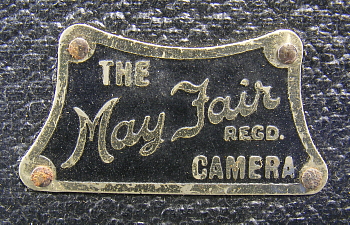
The May Fair folding camera has a distinctive "eye" shaped black and silver coloured enamelled panel around the Novo-Ray lens. The camera is of a conventional folding format, with a metal body that is covered in black simulated leather cloth, while the internal face of the baseboard is finished in a black rippled ("crystalline") finish. The maker's name is stamped into the leather on the rear of the camera and is clearly identified as the Houghton-Butcher Mfg. Co. Ltd. The camera has two aperture settings, marked "Very Bright" and "Ordinary" and a three speed shutter with Time and Bulb settings. The camera has a conventional viewfinder that can be rotated for portrait or landscape use, but it also has a "direct vision viewfinder" consisting of a wire frame that swings out from the lens standard and a small sight that can be pushed up from the back of the camera. This same style of wire frame finder is found on other cameras made by Houghton-Butcher in this period, but was also adopted by other makers.
The box camera that is commonly found also has a similar finder arrangement, although in this case the wire frame pulls out from the side of the front section of the camera. It also has conventional bright finders for landscape and portrait use, although they are quite small. The main body of the box is covered with black simulated leather cloth, while the front and rear panels adopt the black "crystalline" finish. Like the folding camera, the Houghton-Butcher name is embossed into the covering, this time on the underside of the camera. The May Fair name is stamped into the leather carry handle mounted on the top of the box camera body.
The shutter of the box camera is built into the front section of the camera body. The shutter has time and instantaneous modes, controlled by a pull-out slider above the shutter lever, and a second slider on the top edge provides two different aperture settings. A unique feature of the box camera is that it has a small compartment with a sprung cover built into one side of the front section of the camera body to hold a portrait lens attachment. The attachment itself is a push fit into the lens opening of the camera. The removable metal film carrier, the front of which holds the lens, has a stencilled note on one side advising the use of Ensign E20 film.
The two cameras are pictured together below, but further details about the May Fair folding camera and the May Fair box camera can be found on the pages on this site dedicated to each.
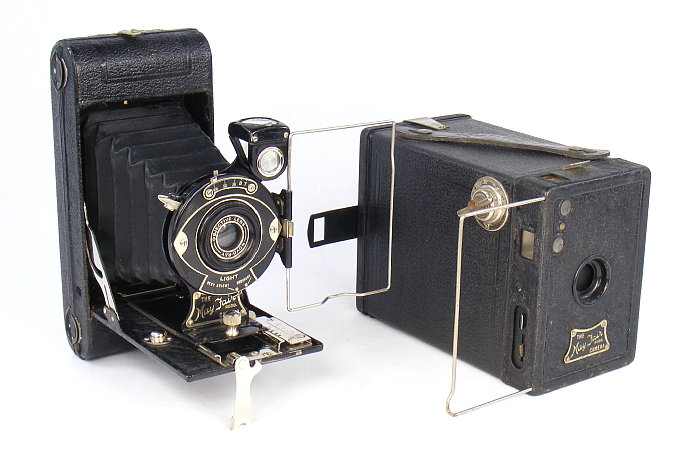
A single set of instructions was produced covering both camera models, confirming that both were distributed at the same time. The association with Ardath products is also stated clearly on the front cover, and Houghton-Butcher is mentioned by name in the text as the maker of the Novo-Ray lens - "a special optical system designed and constructed by The Houghton-Butcher Mfg. Co. and used exclusively on their cameras". This set of instructions is date stamped 1931.
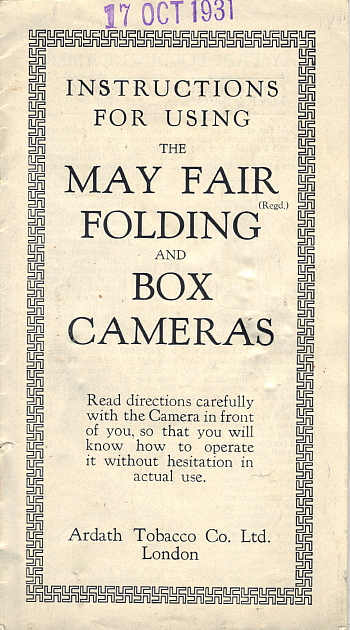
Note that the instruction booklet quite clearly identifies the camera as the "May Fair" (two words) and the name shown on the camera badge is also capitalised as two separate words. However, the catalogues simply refer to the cameras as "MAYFAIR" (one word). A series of records were also available under the premium scheme in the same period, and interestingly the record label shows the name in hyphenated form as "May-Fair".
The illustration below shows an extract from Ardath catalogue number 391 (believed to date to 1931), which shows both the folding and box camera, but no others. The folding camera required 395 coupons, while the box camera required just 130 coupons. The portrait lens was available for a further 30 coupons, but the box camera and portrait lens accessory could be obtained together for 150 coupons. This perhaps explains why quite a few box cameras appear without the attachment, although of course some may simply have been lost.
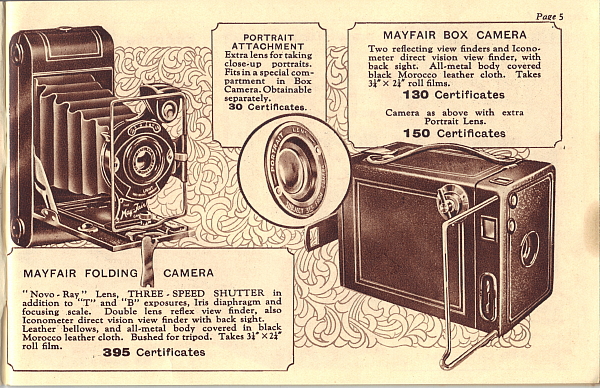
A later catalogue, issue 947, illustrates a revised pattern of the May Fair box camera. The wire frame finder has gone on this model, but otherwise it is essentially the same as the earlier box camera. The portrait lens is still listed as an optional accessory. On the example I have of this later form of the box camera, the maker's name is not embossed into the leather cloth covering, and there is no stencilled label on the film carrier prompting the owner to purchase Ensign E20 film.
Despite being simpler than the earlier version, the box camera is identified in the catalogue as the "De Luxe" box camera. A canvas case is also illustrated for this camera, requiring a further 40 coupons. Alongside is shown a different format box camera, identified as a "new model", which is based on the box camera for 2" x 3" (E29) film produced by Houghton-Butcher. This E29 box camera was much used with other premium schemes. In common with the other cameras, it has the May Fair badge on the front face, and is finished in black leather cloth. It required a slightly lower number of coupons to be redeemed than the De Luxe (110 rather than 130).
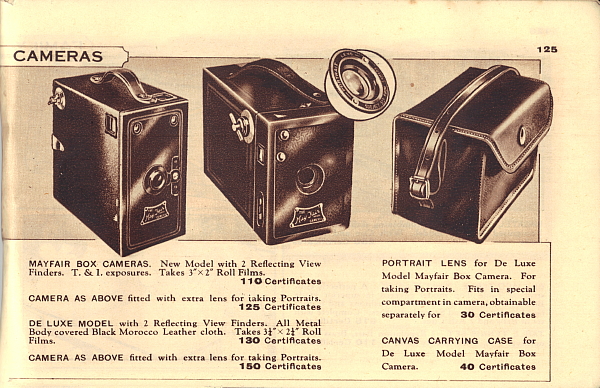
The catalogue entry shows the new camera fitted with a portrait attachment, as found on the blue coloured E29 box camera that was distributed through John Bull magazine and other premium schemes. The example in my collection of the May Fair E29 box camera does not have the portrait attachment, although it does have the simple screw fittings that would be used to mount it. The catalogue entry shows two different coupon exchange values: one with, and one without the portrait attachment. The single sheet instructions that came with the camera describe its use.
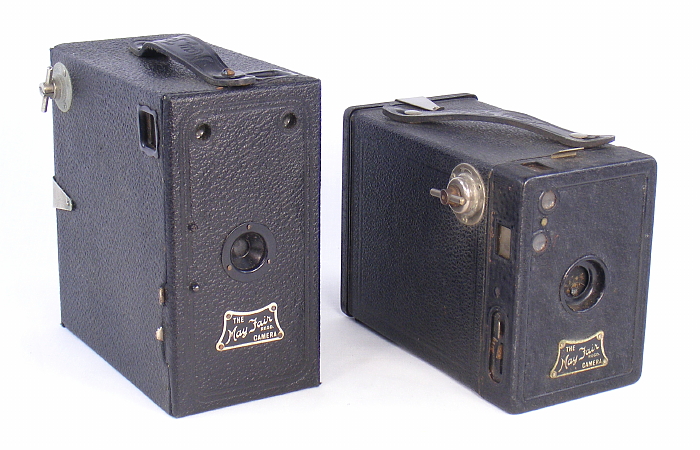
Catalogue issue 947 also introduces two more folding cameras alongside the version with the Novo-Ray lens described previously. One is a very basic model, identified as a new model, while the other has a superior lens and shutter; both take pictures of size 2¼" x 3¼" (120 / E20 rollfilm).
The basic model is of simple pressed steel construction, painted black but with the rippled crystalline finish. The lens surround is a round plate carrying a simple but attractive geometric design. It has a basic single speed shutter with Time and Bulb settings and meniscus lens with two stops (marked for Ordinary and Brilliant light). The May Fair name is shown on a roundel incorporated into the rail assembly attached to the baseboard. There are two preset focus positions for the lens standard to latch against, marked for views and close-ups.
The maker is not identified on the camera but there are a number of features that strongly suggest that this camera was also made by Houghton-Butcher. The most obvious characteristics are the tripod bush mountings on the bed and side of the camera body, and the support struts that hold the baseboard in place when the camera is open. This basic Mayfair model is very similar to the Ensign Pocket "Twenty" camera, which was the entry level folding camera in the Ensign range in this same period.
The original May Fair folding camera with Novo-Ray lens is now identified as the De Luxe folding camera in catalogue 947, but otherwise appears to be unchanged.
The third folding model is identified as the Super May Fair camera on the label on the camera itself. It is equipped with a Gloriar Anastigmat f6.3 lens but has the same 3 speed shutter as the De Luxe camera. Again, the face plate around the lens carries a distinctive geometric design. The rest of the camera body and fittings are essentially the same as those on the De Luxe model, although the covering appears to be leather rather than leather cloth. However, the name badge is different to that used on the rest of the cameras as it has been modified to include the word "Super".
Like the basic model, the maker's name is not identified on the Super May Fair camera, but given the large number of common features with the De Luxe camera, it is reasonable to assume that this camera was also manufactured by Houghton-Butcher. Comparison of the two cameras in a side view makes this very apparent.
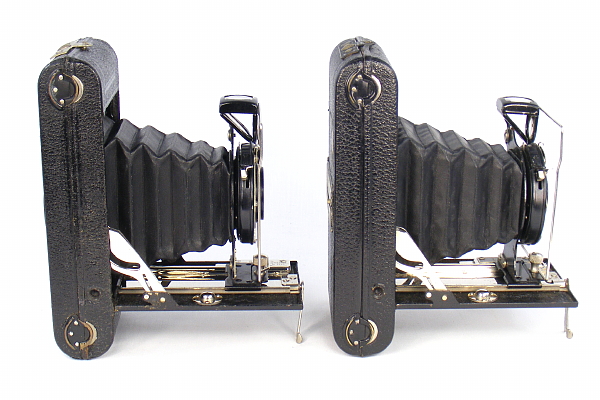
A further convincing piece of evidence that the camera came from the same maker is the fact that the Super May Fair has the same patented hinged film spool holders (patent number 281802) as the De Luxe, Houghton-Butcher being the patentee.
The Super May Fair camera is also described in the catalogue entry as the "3 guinea camera", reinforcing the view that it was being promoted as a high quality item. Note too that the catalogue description incorrectly identifies the lens as a "Gloria" rather than "Gloriar" as marked on the lens itself. (Even more curiously, in the earlier catalogue No 800, it identifies the name as the "Gloris"!). The catalogue text refers to the wire frame finder arrangement - the same as that found on the now renamed De Luxe model - as an "Iconometer direct vision view finder with back sight".
The number of coupons required in exchange for each camera varies significantly, starting at 295 for the basic folding model, 395 for the De Luxe and then a big jump to 695 for the Super model. Note that the Super model is advertised as a special offer that closed at the end of December 1933, with a statement that this model normally required an exchange of 850 coupons.
A leather case, suitable for any of the three models, was available for a further 70 coupons.
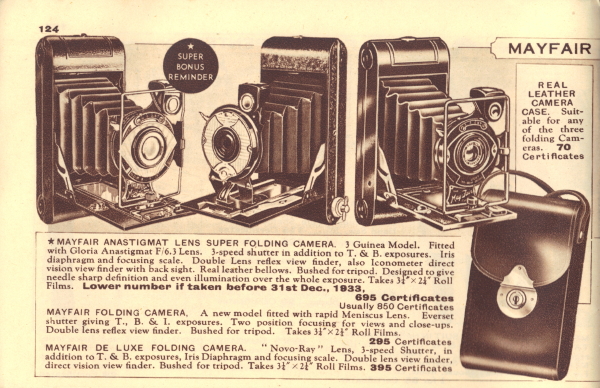
The photo below shows the same three cameras from my collection for comparison.
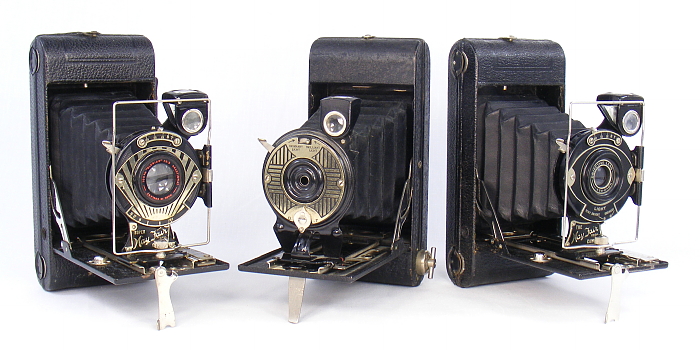
As stated earlier, the basic model shown in the centre of the photo appears to be an adaptation of the Ensign Pocket "Twenty" camera - the entry level model in the Ensign range in the early 1930s. The May Fair De Luxe (right) is likely based on the Ensign Pocket No 2 camera, while the better quality Super May Fair appears to be based on the No 3 Ensign Carbine, which has a leather covering rather than the "leather cloth" (leatherette) used on the De Luxe model. This would also explain why the Super May Fair is also described as the "3 guinea camera", as this was the approximate list price of the No 3 Ensign Carbine at that time.
The photo below shows the No 3 Ensign Carbine and the Super May Fair side by side for comparison.
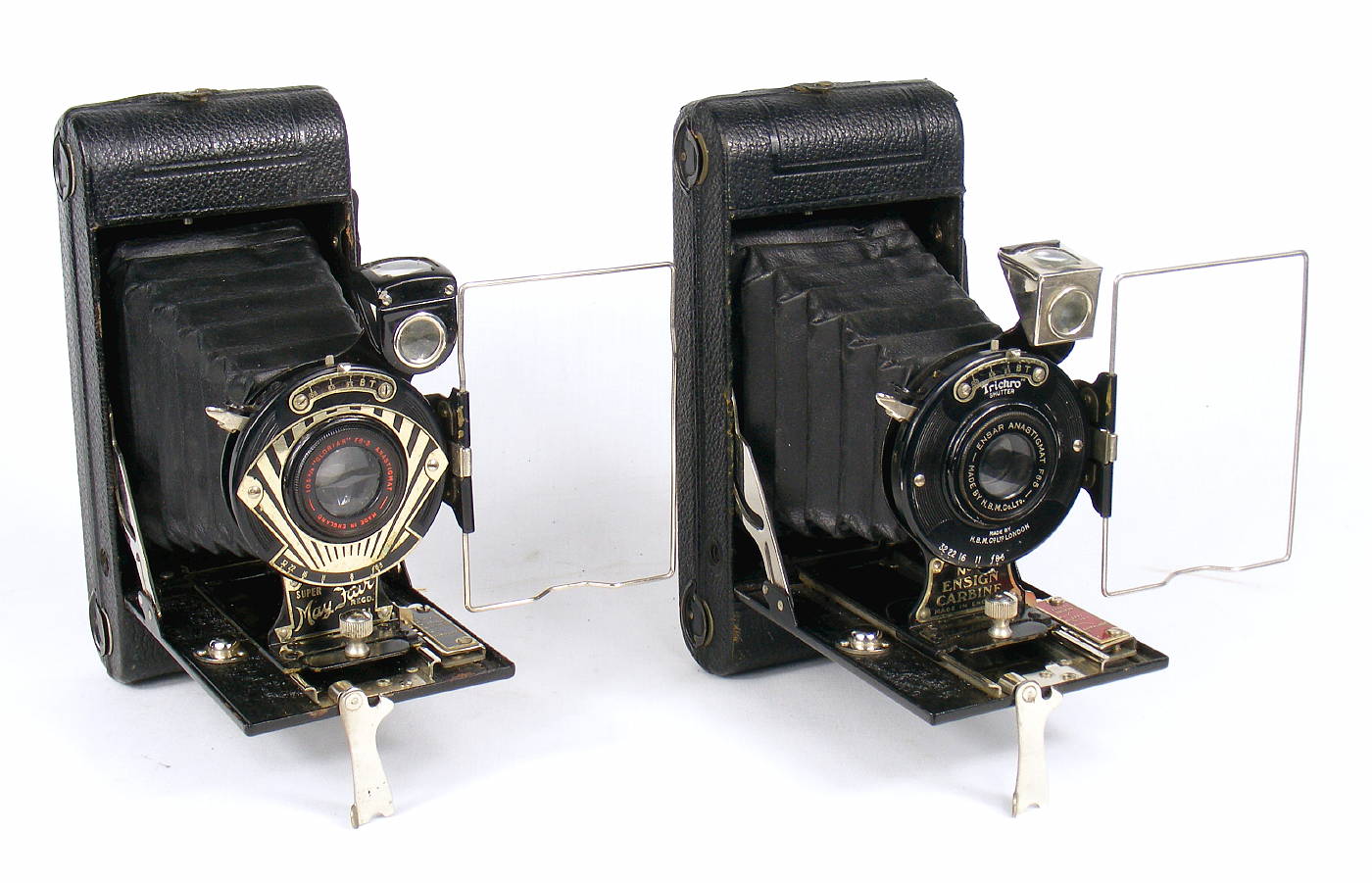
Since writing the article for Photographica World I have acquired a further reminder catalogue, identified as a supplementary list for new reminders, and number 800 in the sequence but with a total of 64 pages. This has a single page of cameras, which carries the banner title "New Mayfair Cameras". Beneath it introduces the "Mayfair Anastigmat Lens Super Folding Camera" at 850 coupons, although curiously without any picture, and the "Mayfair Folding Camera" at 295 coupons. The page also lists the original folding camera, but now identified for the first time as the "De Luxe", presumably to differentiate it from the two new models. Curiously the new models are identified with a number in the catalogue (552 and 3257 respectively) both against the drawings and in the text. These numbers do not appear in any other catalogues or against the other cameras, although numbers do appear against some other higher value items such as clocks in the same catalogue.
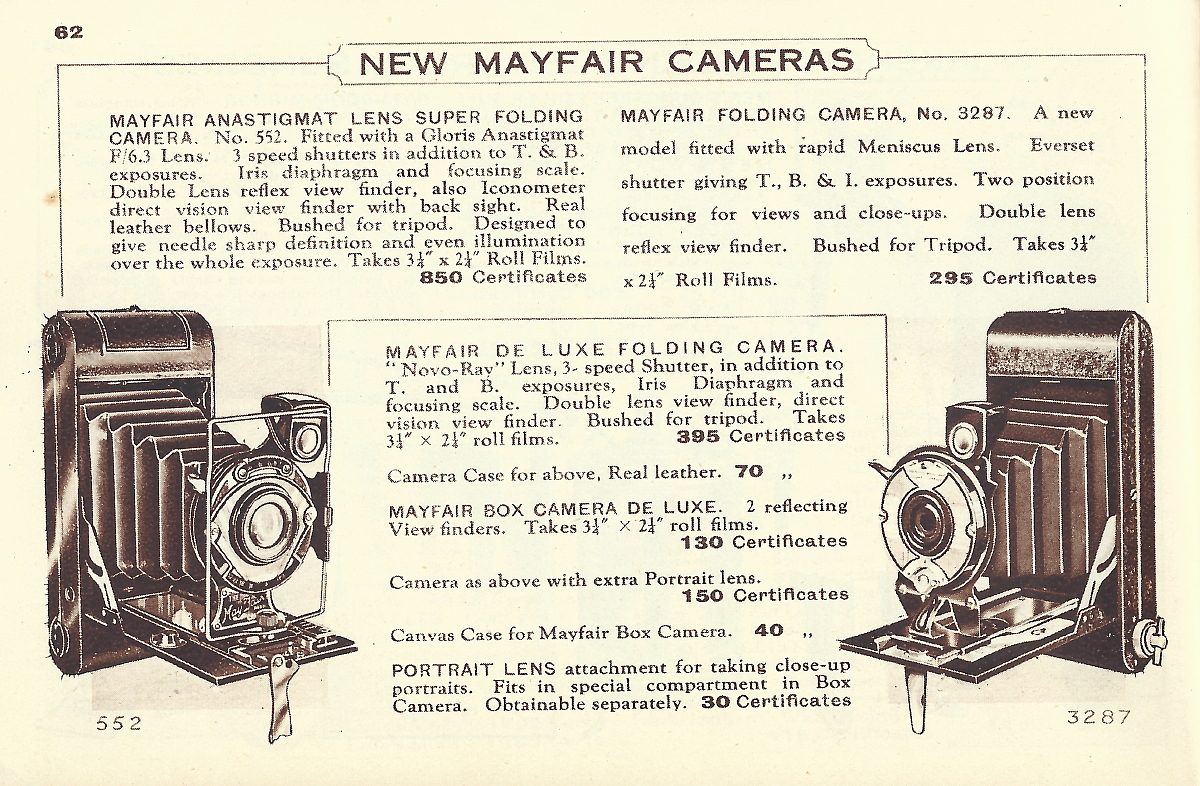
Ardath Reminder Catalogues
I have a number of different Ardath gift (reminder) catalogues in my possession, which I believe span the period 1930 to 1933. The table summarises the characteristics of each catalogue and the cameras illustrated in each with the number of coupons required shown in brackets thus [xx].
| Issue | Pages | Date | Camera Content |
| 358 | 24 | 1930 | Mayfair Folding Camera (Novo-Ray lens) [395]
Mayfair Box Camera only [130] or with portrait lens [150]; portrait lens also listed separately [30] |
| 391 | 48 | 1931 | Mayfair Folding Camera (Novo-Ray lens) [395]
Mayfair Box Camera only [130] or with portrait lens [150]; portrait lens also listed separately [30] |
| 716 | 72 | 1933 | Mayfair Folding Camera (Novo-Ray lens) [395]. Leather case [70]
Mayfair De Luxe Box Camera only [130] or with portrait lens [150]; portrait lens also listed separately [30]. Canvas carrying case [40] |
| 800 | 64 | 1933 | Single page showing cameras carrying the banner "New Mayfair Cameras"
Mayfair Anastigmat Lens Super Folding Camera No 552 [850]; Mayfair Folding Camera No 3287 [295] Mayfair De Luxe Folding Camera (Novo-Ray lens) [395]. Leather case [70] Mayfair De Luxe Box Camera only [130] or with portrait lens [150]; portrait lens also listed separately [30]. Canvas carrying case [40] |
| 947 | 128 | 1933 | Mayfair Folding Camera [295]
Mayfair De Luxe Folding Camera (Novo-Ray lens) [395] Mayfair Super Folding Camera [695, reduced from 850] Leather case to fit any of three folding cameras [70] Mayfair Box Camera (E29) only [110] or with portrait attachment [125] Mayfair De Luxe Box Camera only [130] or with portrait lens [150]; portrait lens also listed separately [30]. Canvas carrying case [40] |
The catalogues that I have managed to collect span a period of 4 years and cover a number range of nearly 600 issues. While I am sure more reminder catalogues exist other than those identified in the table, it seems likely that many of the interim issue numbers corresponded to smaller clearance lists or other specialist listings. I have some examples, acquired along with the main catalogues. Issue 520 is a small booklet listing Mayfair gramophone record titles that were available and, unusually, is also marked with a date of January 1933. Issue 723 is a folded pamphlet listing a series of clearance items available for a reduced number of certificates, while stocks last. Issue 751 is a single sheet listing novels that were available.
What is very clear from the page count for each catalogue is that the number of gift items that were available over this period increased substantially, reflecting the competition between the different tobacco companies in their campaign for brand loyalty.
Early catalogues such as issue 391 encourage the reader to visit the Ardath showroom at 22 Worship Street, London where the gifts could be examined and exchanged for coupons. Customers could also send in their coupons by post. Later catalogues such as issue 947 records the address of the showroom as 98 Regent Street, London and it is believed that the change in showroom address occurred sometime late in 1931. Catalogue 947 encourages customers in Scotland to visit the showroom at 88 Union Street, Glasgow; this is the only catalogue of the four that shows this address.
Since writing the original article for Photographica World, I have acquired another reminder booklet, although only consisting of a single folded sheet. While this has no camera content, what it does show is an impression of the entrance to the showroom at 98, Regent Street.
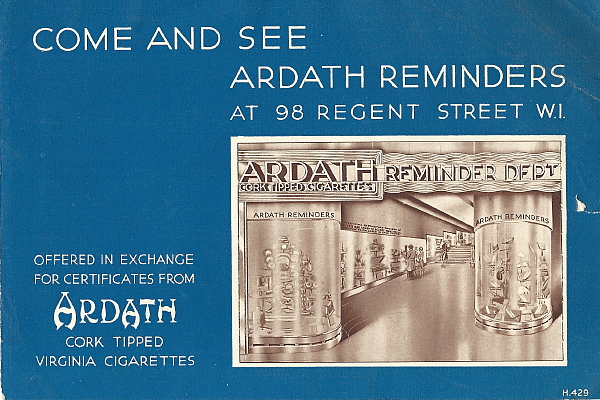
A further view is shown on one of the inner pages, as shown below, suggesting that the showroom was quite a glamorous and substantial set up. The text alongside the picture also refers to the Regent Street showroom as being "new". Unfortunately there is no other dating information. The issue number hints at a possible date of 1932, but this is not consistent with some other information that suggests that this new showroom might have opened in 1931. This is still being researched to see if the date the new showroom opened can be pinned down.
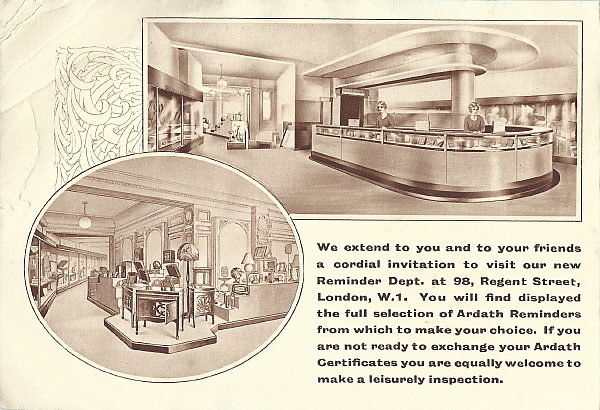
A further address that appears on packaging is 13 Margravine Road, London W6, which is shown as the return address for undelivered items. This has been seen on packaging for an early May Fair Box Camera and is also shown on the packaging that came with my example of the E29 Box Camera, suggesting that this return address applied throughout this period. The address corresponds to the rear of a factory site occupied by Imperial Tobacco on Fulham Palace Road, and sold off by auction in December 1934.
Summary
Based on the catalogue content, as presented in the table above, it appears likely that the basic folding camera and the E29 box camera, both identified as new models in issue 947, only became available late in 1933 and therefore only shortly before the coupon scheme ended. While it appears that the Super May Fair was introduced a little earlier, it seems likely that it too appeared during 1933. This might account for the comparative scarcity of these particular models today. The folding model with the Novo-Ray lens and the box camera for 120 rollfilm are common, but were available over a very much longer period, albeit with a change in name on the way and a modification to the design of the box camera.
Another factor affecting the availability of some of the cameras might also be the coupon exchange values themselves. The basic folding model required 295 certificates, while the De Luxe version with the Novo-Ray lens required 395 certificates. It is possible that the relatively modest uplift in the number of coupons between these two models encouraged people to go for the better model. Furthermore, the Super May Fair required 695 certificates and comparing this to other items in the same catalogue, it does not surprise me that this camera does not appear very often when you consider that a similar number of coupons could be exchanged for items such as a superior wind-up gramophone or a golf bag, complete with clubs and irons.
The coupon shown pictured at the top of the page notes that three coupons were supplied with every 10 cigarettes and shows the early Worship Street showroom address. However, catalogue 520 that is dated January 1933 has a panel on the back that states that one coupon was supplied with every 10 cigarettes, so there was clearly a change to the scheme in the intervening period. At 10 cigarettes per certificate, these coupon exchange values correspond to an awful lot of smoking, at quite some expense.
It is not known whether there was any camera stock that had to be disposed of by Ardath when the coupon exchange scheme was terminated. It is known that the remaining record stock, together with radios and gramophones, were bought up by Selfridges and sold on promotion. It is possible that any remaining cameras were disposed of in a similar way.
As far as my investigation has been able to establish, the cameras presented here are the entire set that were available badged with the May Fair name and from the evidence available, I believe it is reasonable to assume that all the models described were produced by The Houghton-Butcher Mfg. Co. Ltd.
If you have an interest in premium cameras, you might like to refer to the Notes section on the page dedicated to the Ensign Greyhound camera. This provides further details about premium schemes run by the tobacco companies in this period.